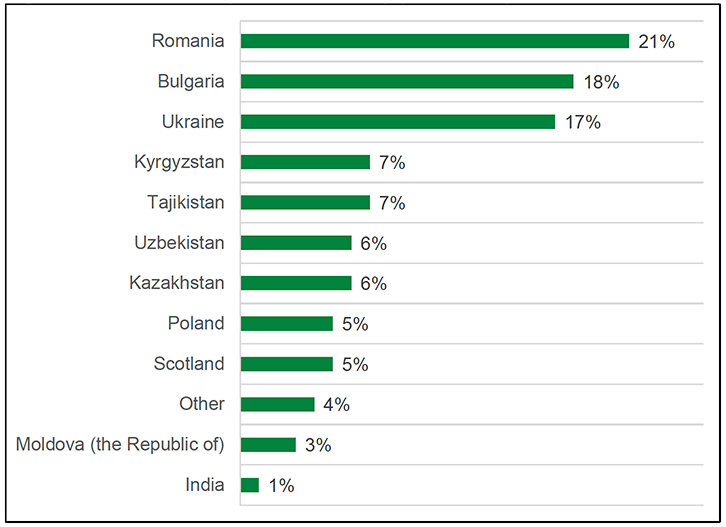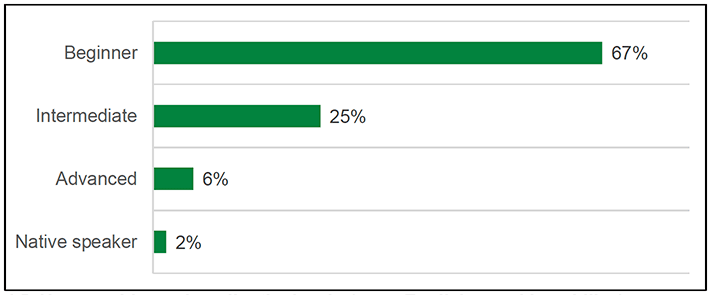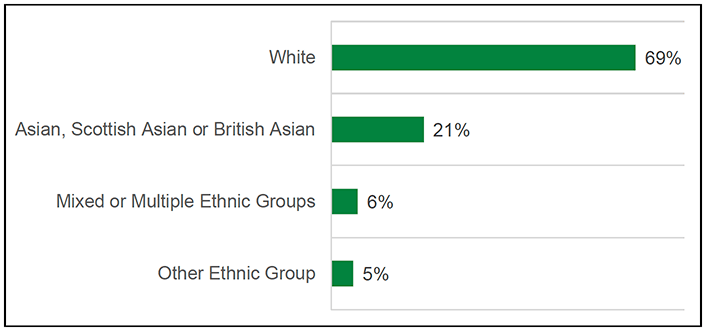Seasonal migrant workers in Scottish agriculture: research report
Outlines the main findings of research into seasonal migrant workers in Scottish agriculture, including: their number and demographics; the experiences of employers and seasonal migrant workers; and the long-term viability of this sector.
Appendix L: Demographic qualities of Worker Survey
Survey respondents had travelled from eleven different countries to work in Scottish agriculture in 2022 (figure L.1). Just over half (56%) of all seasonal migrant workers who responded to the survey came from one of three countries: Romania (21%), Bulgaria (18%) and Ukraine (17%). Those seasonal migrant workers from Kyrgyzstan (7%), Tajikistan 7%), Uzbekistan (6%) and Kazakhstan (6%) made up a quarter (26%) of the sample. Other countries included Poland (5%), Moldova (3%) and India (1%). Interestingly, only 5% of seasonal agricultural workers were from Scotland.

Q1. Please select your home country
Base: n=439
Note: Those respondents selecting Scotland for this question were routed to the end of survey as they cannot be classified as seasonal migrant workers.
Over half of the seasonal migrant workers were male (58%) while approximately two out of five (42%) were female. This finding relates to accounts that a growing proportion of workers are now female (see section 4).
The age of seasonal migrant workers who responded to the survey ranged from 18 to 62 years with an average of 33 years.
Two thirds (67%) of seasonal migrant workers described their level of English-speaking ability as beginner, while a quarter (25%) rated their ability as intermediate. Only 6% of migrant workers describe themselves as having advanced English-speaking ability and even fewer (2%) were native speakers (figure L.2). This finding supports the necessity of providing information to workers, and assistance to workers in a range of languages.

Q5. How would you describe the level of your English-speaking ability?
Base: n=400
Over two thirds (69%) of seasonal migrant workers described themselves as White (figure L.3). Other backgrounds include Asian, Scottish Asian or British Asian (21%) and Mixed or Multiple Ethnic Groups (6%).

Q6. What is your ethnic group?
Base: n=399
The vast majority (97%) of migrant workers in Scottish agriculture were not limited because of a health problem or disability which has lasted or was expected to last at least 12 months. Only 2% of workers were limited a little whereas no migrant workers were limited a lot by a health problem or disability. This finding does relate to how employers and stakeholders described the tasks seasonal migrant workers conduct on the farms as hard work and manual work (see chapter 4).
Contact
Email: socialresearch@gov.scot
There is a problem
Thanks for your feedback